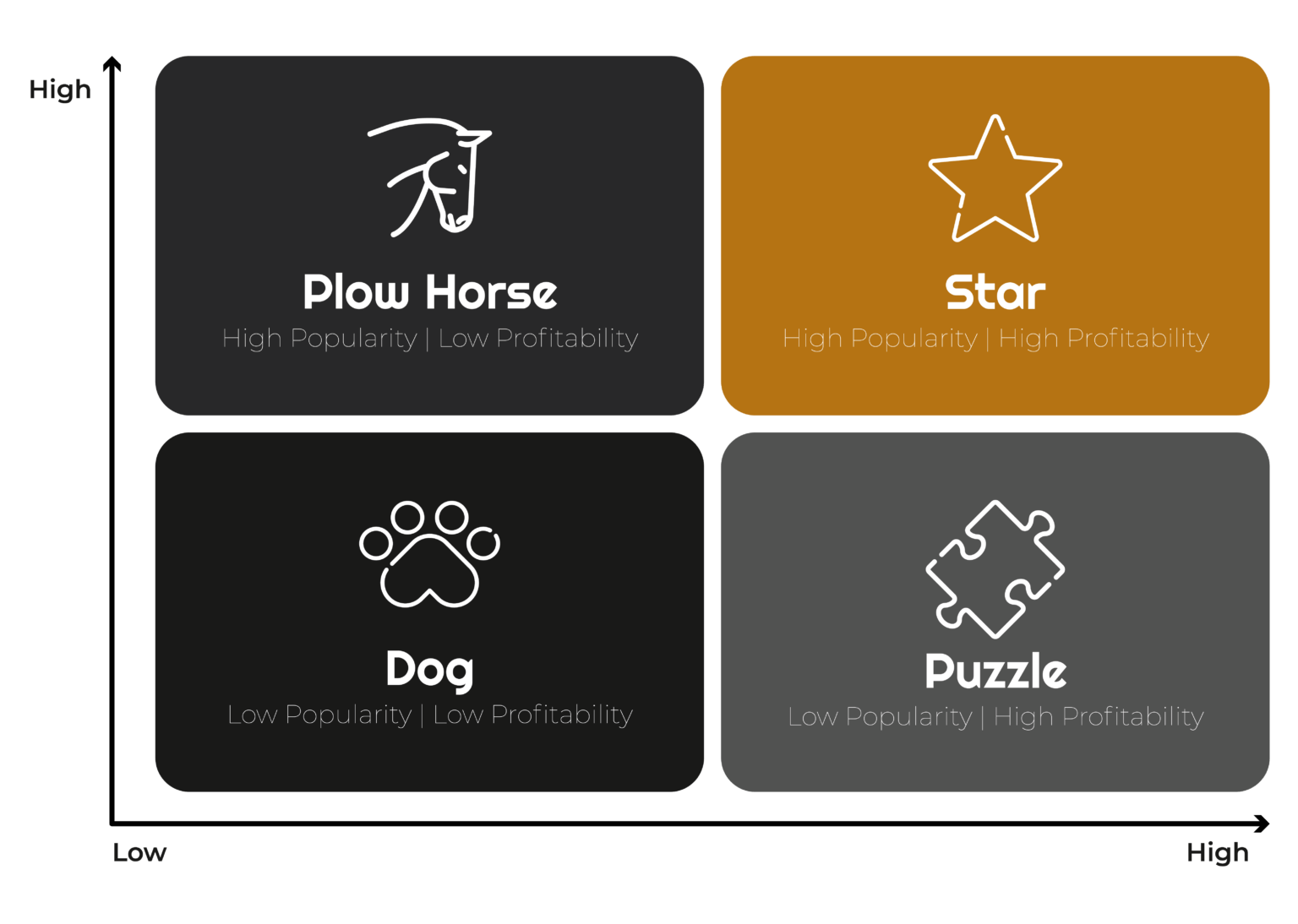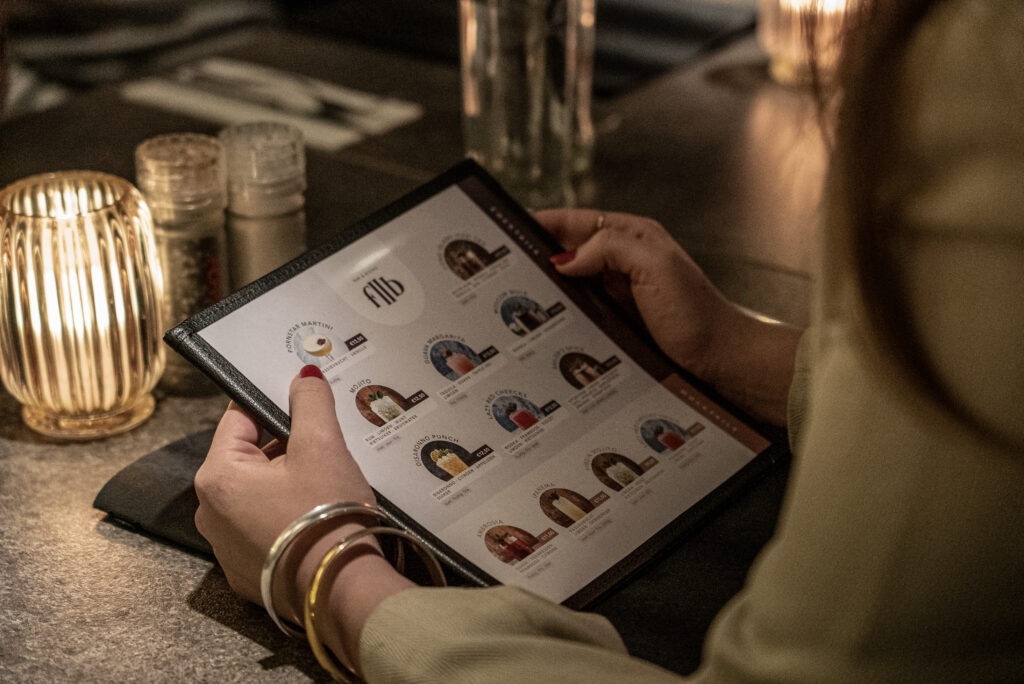The psychology behind the menu: cocktail edition
Every word, image or position on a menu has a message. Sometimes very clear and transparent, but sometimes subliminal. So subtle that as a guest you don't even notice it. That doesn't mean those messages are any less important. On the contrary: it is a fallacy to assume that the looks, structure or tone of voice of your menu are negligible. They just play a huge role in the decision-making process of your customers and, consequently, the profitability of your business. Unfortunately, it remains something that many business owners do not pay enough attention to. Time for a change! Together we dissect your menu and rebuild it step by step, based on an underlying psychology.
Examining and categorizing your current menu
Have you ever properly evaluated your menu? Really taken a close look at it? It's very valuable to do that from time to time, as well as to do this thought exercise every time you revamp: which items on your menu give you a lot of margin and which do not? Which of them are very popular, and which are not? By dividing your menu items into a matrix, you categorize your menu into four major groups: plow horses, dogs, stars and puzzles.
Why is that so important? Some categories are more interesting to you as a business owner than others. That's how you know which items are really worth putting on your card and determine what place they take on your card.

PLOEGPAIRE
WINS: Low
POPULARITY: High
Ploughshares are menu items that have a low profit margin, but are highly sought after by the general public. So it is important to put and keep them on your menu. Consider, for example, a classic steak or a dish with a more special type of fish at the restaurant. In terms of cocktails, this is where you can put the Negroni, for example.
You can play a little with the profit margin by adjusting the portion or using cheaper ingredients to create it, for example.
Do you notice that they are really bringing in too little or almost nothing? Then it may be time to say goodbye.
STARS
WINS: High
POPULARITY: High
The stars are clearly the star of the show. How could it be otherwise? They have a high margin and are also very popular with your customers.
In terms of food, for example, these are popular pasta dishes. Then, in cocktails, you will find the Mojito, Pornstar Martini, Espresso Martini or Lazy Red Cheeks.
You may really promote these stars on your menu. They deserve a superior place to the other menu items. Highlight them with special formatting or give them plenty of white space.
DOGS
PROFIT: Low
POPULARITY: Low
This category consists of items that do not fetch much and are also not that popular. It makes sense that these items don't actually deserve a spot on your menu.
Still, in restaurants, it is sometimes interesting to keep a few "dogs" on your menu. For example, it is also about meals for little ones, such as balls in tomato sauce for children. That may not be sold very often, but it is important for families. If your business appeals to that target group, you should offer such dishes.

PUZZLES
WINS: High
POPULARITY: Low
Puzzles are obviously also important for your menu, especially since they have a high profit margin. However, they are not as popular as stars or plow horses, so you don't benefit as much from that high profit margin.
So it is up to you to make sure that this category is well promoted. Sometimes it may make sense to slightly pimp the menu items so that they are sure to be ordered enough.
All well and good, but what do you do with this information? How do you position these different categories on your menu? And what does that ideally look like? It pays to completely dissect and rebuild the looks, structure and tone of voice of your menu.
The looks of your card
When we talk about looks, we are talking about everything purely visual. It's not about the texts or the overall structure, but rather the use of color, the material used, the format, ...
The Format
There is nothing more annoying at the table than clumsily trying to handle a menu that is far too large. Moreover, it is not easy to make your choice and your guests may even get frustrated. You definitely want to avoid that. So choose a handy size that waiters can easily carry around. Not sure? Test out several possible options!
The use of color
Colors have a big impact on emotions, information processing and people's behavior. So it also makes sense to think twice before choosing just any "pretty" color for your menu, let alone for your company's branding. Keep in mind the underlying meaning of color and the effect they can create. For example, green is associated with freshness and health. Orange, for example, stimulates hunger. Red encourages action and yellow is just a super happy color that grabs attention.
The pattern
Try to follow a pattern in the formatting of your card. Do you need about three lines in the description of a dish or cocktail? If so, always use three lines. That also allows you to deviate from the pattern when you want to highlight something. Remember those "Stars" from above?
The material
Of course, the material chosen for the card also plays a role in your customers' decision-making process. You can't expect a card that looks cheap to entice customers to spend a lot of money on a simple dish. Are you serving superior cocktails? Then it's best to present it with quality material. Thick paper or even leather are recommended. It goes without saying that your cards should always be clean and correct.
The structure of your map
The structure of your map is next on the agenda. It's really about the structure of the map then.
The Golden Triangle
We'll start right off with the most important element in menu card psychology: "The Golden Triangle. That golden triangle runs from the center of your menu, through the top right side to the top left side. Why that one is golden? That makes sense: because it can get you the most.

Research shows that visitors take an average of 109 seconds to decide what they would like to drink. In those 109 seconds, they look at that "Golden Triangle" the most. So it pays to highlight the high-profit products here: the Stars and the Puzzles.
Moreover, usually the first two items in a section are chosen most often. Sometimes that is also the last item. So high-margin dishes or cocktails belong there. If possible, also try putting the most expensive item first. This creates the illusion that the following items are "cheap. Visitors then quickly tend to choose something cheaper, but order this more often than they would order the expensive item. That repeat purchase earns you that extra margin.
The number of items on your menu
What about the number of items on your menu? That's another question often asked by a lot of hospitality business owners. One thing is certain: too much choice makes us restless and even stresses us out, making us uncomfortable and sometimes not making a choice at all. Psychologists recommend that restaurant owners best limit options to 7 to no more than 10 items per category. On average, 80% of guests are not sure what they want to eat before they step into your establishment. The majority of those guests are likely to order the first thing that catches their attention.
In fact, it is so striking that it has been given a name: "The Paradox Of Choice. You want to avoid that at all costs. Provide plenty of variety, but don't make it overwhelming. How's that for cocktails? In our blog on the ideal composition of your menu, find out which categories we recommend for your catering business.
Make what should stand out stand out
Want to make something really stand out? Then you need to do so literally. By using some extra white space around the item, a special color or a separate font. You can even literally frame the item so that it is immediately clear to your guests that this really is a special item .
BONUSTIP
Do you have lots of quality photos of your dishes and cocktails? Use social media to share these beautiful images. That way you'll appeal to a wide audience and convince a lot of people online to definitely stop by and enjoy those beautiful creations. Place a link or QR code on your menu to your socials and possibly a hashtag to make it very easy for your guests to share their own pictures as well. Hello, social proof!
The tone of voice of your card
When we talk about the tone-of-voice of your card, we are talking about everything to do with the choice of words and the story your card tells. That story should be easy to understand, and an honest representation of what your business stands for.
The description of your menu items
Keep it simple
The first tip we'd like to give you here is: be careful not to over-complicate your menu. Your guests don't care about every detail or technique that goes into the creation of your cocktail. Focus instead on the flavor and ingredients. The key flavors of the creation, so your guests can almost taste it already. Is the description too complicated? Then it's too stressful for your guests. That's not a pleasant experience!
Process stories
Try incorporating stories into your dishes' names and descriptions. What do you think when you read "grandmother's way"? Right yes! Descriptions like "from our own herb garden" or "freshly grown" also do well. Anything involving authenticity and freshness usually does well. Find out what fits your business and dishes, and if necessary, ask your customers for help. They know exactly what they taste, and are probably best at describing the feeling they experience.
Do you work a lot with local products? Then it is also very valuable to mention this. Your steak always tastes better when you know it came from the artisanal butcher from "around the corner. Even if you buy the honey, herbs or bread locally, you can mention this.

Use alliterations
Sensually sipping a delicate drink. Sounds good right away! Alliterations are very nice to use in your menu because it often just sounds nice and you can pronounce it smoothly. And if it sounds nice, it will be tasty too, right?
The spelling of the price
Another thing that affects the tone-of-voice of your menu is the spelling of the price. While this may be a detail to many people, it turns out to have a notable impact on how your customers interpret the prices.
Currency sign or not?
Specialists recommend not using the currency sign (€, $, £ ...). That takes away the value of the money, making visitors inclined to spend more. For many people, it subconsciously doesn't feel like you're spending money when there's no currency sign, as strange as that sounds. Not a fan of it? You can also choose to write it out entirely in letters.
Down the track
In addition, don't use a price trail. Those are the dots after a menu item that lead to the price. That takes the focus away from the description and literally brings it to the price. Do you have a lot of price differences in your offerings? Then it's better not to put the prices in a column next to the descriptions anyway, but for example below the description each time. That makes it less easy to compare prices.
0.99 is just under a euro
Another trick that might surprise you? Never, ever use an amount ending with ,99. Research shows that this unconsciously comes across as too cheap and therefore not qualitative. You can possibly use .95 but only if the intention is precisely to give the impression that your guests are getting a good deal. If you want to ensure a premium appearance, you should choose a full number, rounded.
Ready to launch stars?
Time to take your menu in hand! Hopefully our tips will also inspire you to get started on the layout, tone of voice and structure of your menu. Take some time, ask for help where needed and discuss it with your partners and staff. By involving several key people, you open up the conversation and create new opportunities for creativity and profitability. Because not only the content, but also the other elements of your menu, play an important role in your daily sales.
Discover our offer
Ask for an offer
Get in touch
Discover our benefits

